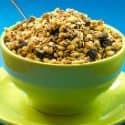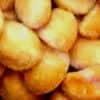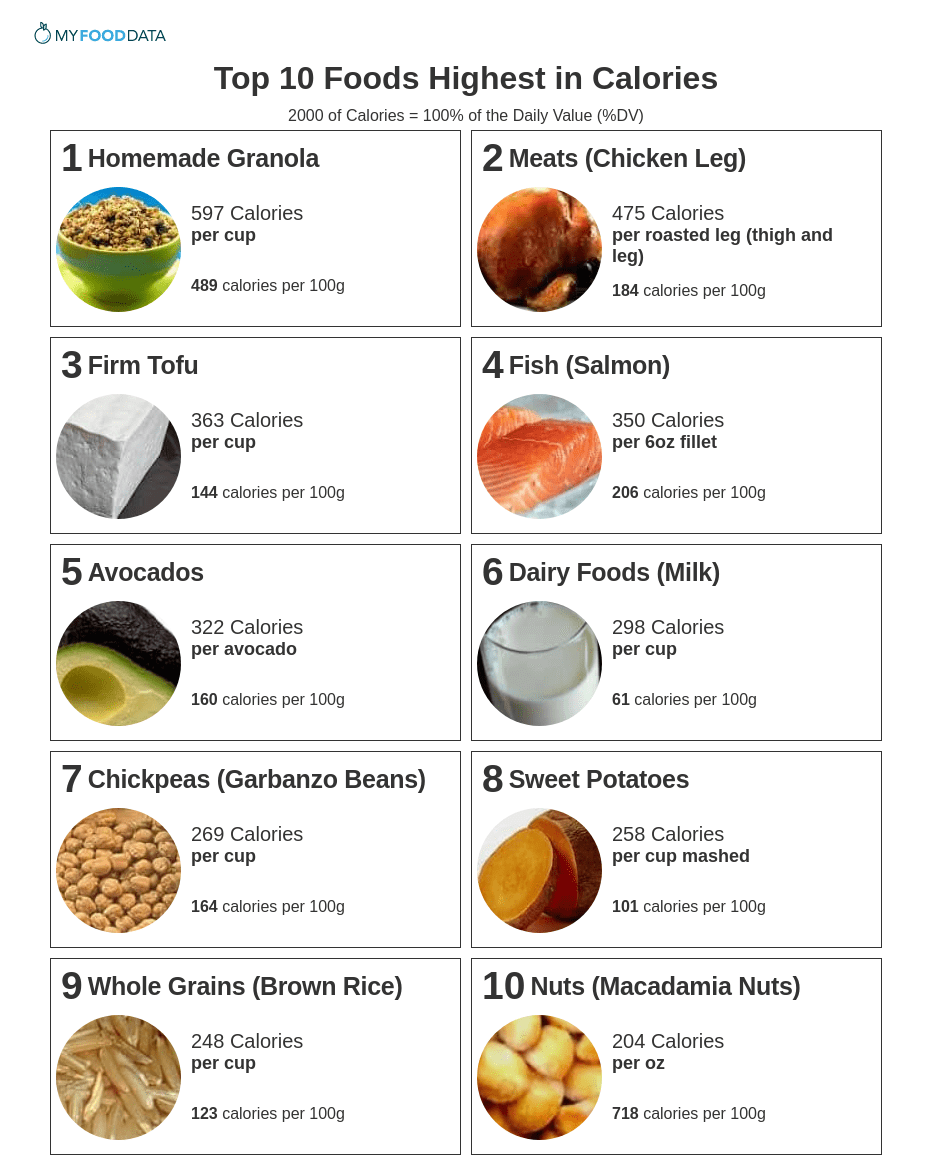Top 10 Foods Highest in Calories

Calories are the basic unit used for measuring the energy in food.
Healthy high-calorie foods include granola, meats, tofu, fish, avocados, milk, beans, sweet potatoes, whole grains, and nuts. The daily value (DV) for calories is 2000 calories per day. (1)
The DV is an average number of calories that a person needs to maintain their body weight and to be physically active at an average level. However, an individual’s daily calorie needs can vary significantly, based on factors like their body size, age, and level of physical activity.
To gain weight in the form of lean muscle mass, you'll need to eat more calories, so that your body has the energy to build muscle. A good target is around 3000 calories per day. You may need to eat more or less than this, depending on how many strength-building exercises you are doing.
Below is a list of the top 10 high calorie foods ranked by common serving size.
If you are looking to lose weight, see the list on unhealthy high calorie foods to avoid.
If you are looking to gain weight, see select meal portions for eating more calories, and the high calorie weight gain meal plans.
List of Healthy High Calorie Foods for Weight Gain
-
 1. Homemade Granola + Add
1. Homemade Granola + Add
Calories per Cup Calories per 100g 597 calories 489 calories Note: Check the amount of sugar in your granola, as some granolas have unhealthy amounts of this. To make it a complete healthy high-calorie breakfast, add nuts and seeds, a few dried fruits, and consume it with milk or milk substitutes.
See all cereals high in calories.
-
 2. Meats (Chicken Leg) + Add
2. Meats (Chicken Leg) + Add
Calories per Roasted Leg (Thigh And Leg) Calories per 100g 475 calories 184 calories More Meats High in Calories
Try to choose lean cuts.- 369 calories in 1 cup of roast ham
- 360 calories in a 6oz of beef pot roast
- 332 calories in a 6oz lean pork chop
- 268 calories in a 5oz chuck steak
- 231 calories in a 1 cup of diced chicken breast
See the full list of high calorie meats.
-
 3. Firm Tofu + Add
3. Firm Tofu + Add
Calories per Cup Calories per 100g 363 calories 144 calories More Soy Products High in Calories
- 376 calories in 1 cup of green soybeans
- 369 calories in 1 cup of tempeh
- 160 calories in a 16 oz glass of soymilk
-
 4. Fish (Salmon) + Add
4. Fish (Salmon) + Add
Calories per 6oz Fillet Calories per 100g 350 calories 206 calories More Fish High in Calories
- 445 calories in 6oz of Atlantic Mackerel
- 313 calories in 6oz of tuna
- 310 calories in 1 cup of canned sardines
See the full list of fish high in calories.
-
5. Avocados + Add
Calories per Avocado Calories per 100g 322 calories 160 calories Other fruits high in calories include plantains, bananas, and guavas. Dried fruit and fruit juices are also very high in calories, but be careful about the sugar content!
See the complete list of over 100 fruits high in calories.
-
 6. Dairy Foods (Milk) + Add
6. Dairy Foods (Milk) + Add
Calories per Cup Calories per 100g 298 calories 61 calories More Dairy Foods High in Calories
- 216 calories in 1/2 cup of ricotta cheese
- 149 calories in 1 cup of plain yogurt
- 119 calories in 1 ounce of grated parmesan
See all dairy foods high in calories.
-
 7. Chickpeas (Garbanzo Beans) + Add
7. Chickpeas (Garbanzo Beans) + Add
Calories per Cup Calories per 100g 269 calories 164 calories More Beans High in Calories
- 255 calories in 1 cup of navy beans
- 254 calories in 1 cup of white beans
- 245 calories in 1 cup of pinto beans
See all beans and lentils high in protein.
-
 8. Sweet Potatoes + Add
8. Sweet Potatoes + Add
Calories per Cup Mashed Calories per 100g 258 calories 101 calories More Vegetables High in Calories
- 161 calories in a medium baked potato
- 134 calories in a cup of green peas
See the full ranking of high calorie vegetables.
-
 9. Whole Grains (Brown Rice) + Add
9. Whole Grains (Brown Rice) + Add
Calories per Cup Calories per 100g 248 calories 123 calories More Whole Grains High in Calories
- 222 calories in 1 cup of quinoa
- 174 calories in 1 cup of whole wheat pasta
- 166 calories in 1 cup of oatmeal
See all high calorie grains.
-
 10. Nuts (Macadamia Nuts) + Add
10. Nuts (Macadamia Nuts) + Add
Calories per Oz Calories per 100g 204 calories 718 calories More Nuts High in Calories
- 196 calories per oz of pecans
- 191 calories per oz of pine nuts
- 187 calories per oz of dried coconut
- 170 calories per oz of almonds
- 167 calories per oz of peanuts
See the list of nuts high in calories.
Printable One Page Sheet

Tips for Gaining Weight
- Add high calorie foods to existing dishes - Nuts, seeds, or dried fruit can make a great addition to salads, rice dishes, pasta dishes, etc.
- Add healthy fats and oils to existing dishes - Add olive oil, peanut oil, or safflower oil to as many foods as possible, such as rice, other grains, pasta, salads, etc.
- Increase portion sizes - Create larger meals of calorie dense foods like rice, mashed potatoes, and pasta.
- Drink Calories - Drinks are an easy way to consume calories on the go. Drink juice, soy milk, milk, smoothies, and other healthy high-calorie beverages.
- Do Muscle Building (Anaerobic) Exercises - Muscle building exercises can increase appetite and also increase weight as your body builds muscle. This is especially true when combined with high protein foods like nuts, peanut butter, fish, or beans.
- Track your progress and set goals - You may want to set goals for weight gain each month. Keep in mind that there isn’t enough solid scientific research to indicate what a healthy and realistic muscle gain goal would be, so choosing a specific goal may be difficult. You'll also want to monitor your body composition to ensure that you're gaining muscle and not fat. Keep in mind that most people will gain muscle more quickly when they first start lifting weights, and this will taper off after you've been training for a while. (2,3) Use the daily food log to track what you eat and make any needed changes.
Select Meal Portions for Eating More Calories
- 1/2 Cup of Macadamia Nuts: 474 calories
- 1/2 Cup of Almonds: 414 calories
- 1 Glass of Grape Juice (16oz): 304 calories
- 2 Slices of Whole Wheat Bread with 2 ounces of cheese and 1 fried egg: 480 calories
- 2 Slices of Whole Wheat Bread with 2 tbsp of Peanut Butter and 1 tbsp of jam: 371 calories
- 1 Cup Brown Rice (Cooked): 218 calories
- 1 Cup Brown Rice (Cooked) with 2 tbsp of Olive Oil: 457 calories
- 1 Cup Oatmeal (Cooked): 166 calories
- 1 Cup Oatmeal with 1/4 Cup Raisins and 1/4 Cup Almonds: 496 calories
- 1 oz Square of Dark Chocolate (28g): 170 calories
- 1/2 Cup of Chopped Dates: 208 calories
- 1/2 Cup of Dried Apricots: 157 calories
From the Nutrient Ranking Tool
Use the ranking tool links below to select foods and create your own food list to share or print.
- Foods High in Calories
- Foods Low in Calories
- Vegetables High in Calories
- Fruits High in Calories
- Vegetarian Foods High in Calories
- Nuts High in Calories
- Grains High in Calories
- Beans High in Calories
- Dairy High in Calories
- Breakfast Cereals High in Calories
- Fast Foods High in Calories
View more nutrients with the nutrient ranking tool, or see ratios with the nutrient ratio tool.
Related
Data Sources and References
- USDA - Calories on the Nutrition Facts Label
- Ahtiainen JP, Pakarinen A, Alen M, Kraemer WJ, Häkkinen K. Muscle hypertrophy, hormonal adaptations and strength development during strength training in strength-trained and untrained men J Strength Cond Res. 2005 Aug;19(3):572-82. doi: 10.1519/15604.1. 16095405
- Haun CT, Vann CG, Mobley CB, Osburn SC, Mumford PW, Roberson PA, Romero MA, Fox CD, Parry HA, Kavazis AN, Moon JR, Young KC, Roberts MD. Muscle fiber hypertrophy in response to 6 weeks of high-volume resistance training in trained young men is largely attributed to sarcoplasmic hypertrophy Front Physiol. 2019 Mar 26;10:297. doi: 10.3389/fphys.2019.00297. eCollection 2019. 30971942
Simplify Nutrition Tracking with MyFoodData!
Speedy Tools and Detailed Data FREEEasily analyze your meals to find the best foods for your goals.
✅ Use our recipe nutrition calculator and nutrition comparison tool.
✅ Access expert nutrition data tools and in-depth articles.
✅ Log foods and organize your recipes with a free account.


 Next ➞
Next ➞
